| Year (from Church plaque) |
Vicar |
Notes (light blue box text directly taken from Leadman) |
| 1260 |
William le Chaplain |
When the Count of Aumale died in 1260 a detailed survey was made of his Pocklington estate, and it named ‘William le Chaplain’. He appears to have enjoyed a long vicariate, or was followed by another William, as a 1297 document notes ‘William vicar of the church of Pokelington’ - Ref Phil Gilbank |
| 1349 |
Robert de Kernetby |
Robert de Kernetby, capellanus, collated 21 October, 1349, by the Dean of York who always presented. |
| 1356 |
Reginald de Senier |
Reginald de Senier, capellanus, collated 17 April 1356 on the resignation of Kernetby. He resigned on being appointed to Chantry of Hamelton. |
| 1364 |
Stephen de Bubwith |
Stephen de Bubwith, capellanus, collated 22 April 1364 and resigned in six months for the vicarage of Bubwith. |
| 1364 |
Adam de Esyngton |
Adam de Esyngton, collated 31 October 1364. He resigned. |
| 1377 |
Dominus Adam vicarius de Pokelington |
A trawl through the 1377 poll tax records turns up ‘Dominus Adam vicarius de Pokelington’; Ref. Phil Gilbank |
| blank |
John Stale |
John Stale, collated ... He resigned for the vicarage of Burnby. |
| 1382 |
Robert de Pokelington |
Robert de Pokelington collated 27 June 1382. Resigned for vicarage of Addingham. |
| blank |
Robert de Hewitt |
Robert de Hewitt, collated ... He resigned . . . |
| 1418 |
Richard de Cleuyng' (or Richard de Clenyng'), the vicar of the church of Pokelyngton', and John Lathome, chaplain |
Reference in Feet of Fines: CP 25/1/280/154, number 4. |
| 1451 |
Richard Yotton |
Richard Yotton, presbyter, occurs in 1451—53. |
| Footnote: Richard Yotton vicar de Poklington is an executor under the Will of Alicia Burgh, pr. Nov. 20, 1453. Test. Ebor. vol. ij. p. Ib7. Again William Felter, Dean of York in his Will pr. April 10.1451 —leaves "Domino hicardo Yotton cs." Ibid., vol. iij., pp. 115-17. |
| 1477 |
Master Robert Conears [Conyers] vicar of the parish church of Pocklyngton |
The 1487 will for Sir Robert Ughtred of Kexby and Kilnwick Percy, was witnessed by ‘Master Robert Conears [Conyers] vicar of the parish church of Pocklyngton’. Ref: Phil Gilbank |
| 1524 |
Edmundo Salvan |
Added by Phil Gilbank - April 2020 (See article below)
Edmund Salvan, was a man of independent means as the tax returns of 1524 show he is the fourth highest taxpayer in Pocklington after John Sotheby, William Dolman and William Lee. The Salvans (or Salvain) were one of the North's leading gentry families and a junior branch lived in a moated manor house at Harswell.
|
| 1539 |
Robert Huyte |
Added by Phil Gilbank - April 2020 (See article below) |
| 1541 |
Johanne Hewitt |
Added by Phil Gilbank - April 2020 (See article below) |
| ... |
Unknown |
Footnote: " Item, I bequeith to the vicar of Poklington my gowne, ye lyeith at Thornton, and one snod of damaske."— Will of Thomas Forne, Sub-treasurer of York Minster, pr. 12 Nov. 1533 Ibid, vol. v. pp. 177-79). |
| 1541 |
Franciscus Parkar |
Franciscus Parkar, clericus, collated 27 May 1541. He resigned. |
| 1549 |
Alexander Smith |
Alexander Smith, collated . . . 1549. Died here and was buried 19 January 1603. |
| ... |
1553 Visitation record |
invent [orie maide the] xx th daie of [August, 6 Edward VI,
betwixt Th'erle of Shrowesburye Syr Rauffe Ellerker .Syr William
Babthorpe John Ecclesfeld Syr Robert Constable Launcelott Alford and
Francis Pairker, theire vicar, Grreine and John Biche . . church
[wardens] . . . . and Robert Sotheby, inhabitantes ....... |
| 1603 |
John Dobson |
John Dobson, collated 19 January 1603. Buried 11 January 1619. |
| 1619 |
Richard Elcock |
Richard Elcock collated January 1619. He was both vicar and Master of Pocklington Grammar School, resigning in March 1622. |
| 1622 |
Leonard Moyser |
Leonard Moyser inducted 25 March 1622. Buried 29 February 1624. |
| 1624 |
James Sotheby |
James Sotheby collated March 1624. He also was vicar and schoolmaster. Buried 12 August 1630. |
| 1630 |
Francis Bland |
Francis Blande collated August 1630. He appears to have resigned. |
| 1641 |
James Hudson |
James Hudson inducted May 1641. Buried 2 August 1673. |
Footnote: Vicar Hudson must have been a pronounced Royalist. It was in his day where the entry occurs in the Registers 1644 " Bellum."
In 1649, Sept. 26, Recognisances for
the appearance at the azzizes of Marmaduke Richardson of Pocklington, clerk, for " praying publickly before his sermon in the parish church of Pocklington for Charles II., Kinge of Scotland and heire apparent to this realme." Depositions from York Castle, p. 24. Surtees Soc
Mr. Richardson had to find sureties for his good behaviour.
Humphrey Sydenham is said to have held this vicarage for a few years during the Commonwealth along with the rectory of Ashbrittle in Somerset, but was ejected from both as he was a staunch Royalist. He died 1650 and was buried at Dulverton, also in Somerset. He was succeeded by a Puritan Minister, named Mayne, a man of inferior talents. |
Note from Phil Gilbank: 'Silver Tongued Sydenham' was wrongly attributed to Pocklington he was in fact vicar to St Andrew, Puckington not All Saints Pocklington.
(Sydenham, Humphrey: B.A. from Exeter Coll. 24 Jan., 1610-11; fellow Wadham Coll. 1613-28, M.A. 3 Dec., 1613; incorporated at Cambridge 1625 (s. Humphrey, of Dulverton), vicar of Ashbrittle 1627, and of Puckington, Somerset, 1629, chaplain to Edward, lord Howard, of Escrick, rector of Odcombe, Somerset, 1644, canon of Wells, deprived of his benefices, and died about 1650.)
On 26th September 1649, Marmaduke Richardson of Pocklington was hanged in York Castle for praying publicly before his sermon for the Prince of Wales, Charles II, King of Scotland and heir apparent.
|
| 1673 |
John Moor |
John Moor B.A. clericus. collated August 1673. Buried 14 July 1707. |
| 1707 |
Joseph Lowe |
Joseph Lowe. M.A. inducted 18 October 1707. He resigned. |
| 1722 |
Thomas Lovett |
Thomas Lovett M.A. of Sydney Sussex College, Cambridge, inducted 2 January 1722, by Dr. Henry Finch, then Dean of York. He died 2 December 1776. It was during his vicariat that the Enclosure Act (1 March 1776) was obtained for Pocklington. |
| 1779 |
Anthony Fountayne |
Anthony Fountayne collated December 1776. He resigned. |
| 1779 |
A F Eyre |
A. F. Eyre occurs as vicar in 1779, with T. Wilcock as his curate. |
| 1794 |
John Coultred |
John Coultred collated 11 May 1794. He resigned. |
| 1796 |
Charles Wolf |
Charles Wolf collated 27 March 1796 and afterwards assumed the name of Eyre in addition. He resigned. |
| 1832 |
Charles Hawkins |
Charles Hawkins B.C.L. inducted 30 March 1832. He resigned 1834. |
| 1834 |
George Alexander Cockburn |
George Alexander Cockburn M.A. inducted 9 October 1834. Resigned 1843. |
| 1840 |
James Francis Ellis |
James Frybcis Ellis . . . 1840. Died 1876. |
 |
| 1876 |
John Henry Wicksteed |
John Henry Wicksteed M.A. Oxon inducted May 1876, resigned 24 September 1893 for vicarage of Bexley, diocese of Canterbury. |
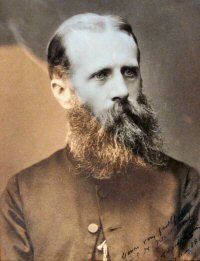 |
| 1893 |
John Mason |
John Mason M.A Cantab., collated November 1883 instituted 9 January 1894 by the Archbishop of York in person. Inducted 13, and read himself in on 14 January. |
 |
| 1898 |
George Herbert Stock |
 |
| 1908 |
Arthur Thomas Fisher |
 |
| 1921 |
Jan McNaughton Smith |
 |
| 1933 |
Ernest Albert Page |
 |
| 1941 |
Ernest Aldington Hunt
Buried in Western Cape South Africa |
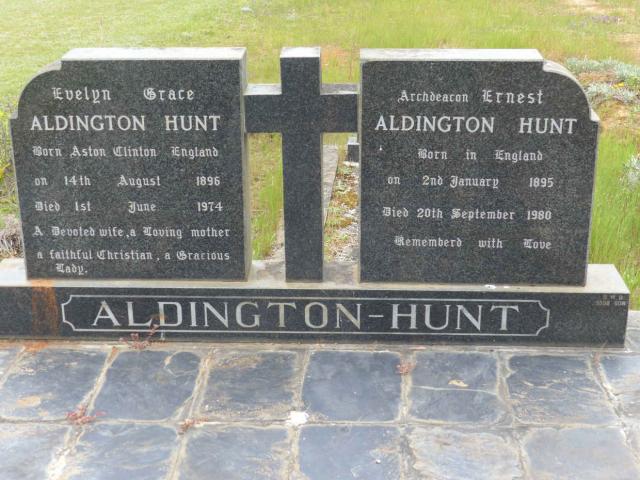 |
| 1943 |
Frederick Richardson |
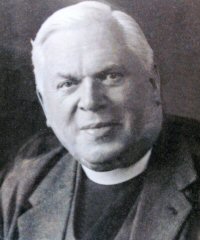 |
| 1960 |
Graham Christie |
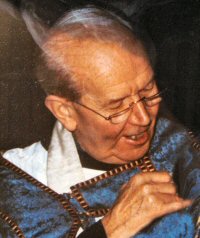 |
| 1982 |
James Woodhouse |
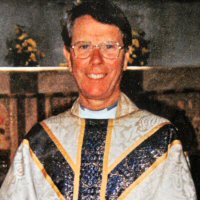 |
| 1990 |
R.Hugh Keble Prosser |
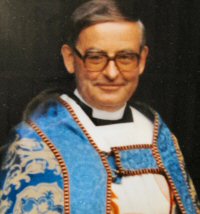 |
| 2002 |
Christopher J. Simmons |
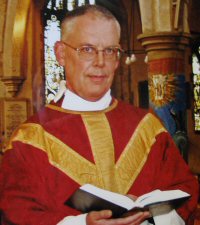 |
| Nov. 2009 to April 2018 |
Geoffrey Hollingsworth |
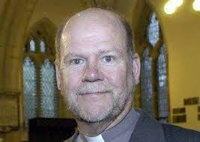
|
| Sept. 2020 to current |
Dr. Jake Belder |
 |
Leadman has a footnote which says, "The list of Vicars is incomplete. Torre only gives ten, Peculiars, p. 683 et seq. From 1549 a complete list is given in the registers"
There was a Chantry in the Church of Pocklington, at the Altar of St. Mary the Virgin, founded 1302. Only two chantry priests are recorded, Sir William Brown, who died, and 27 November 1545 Sir William Mudy or Moodie who was the last, as chantry priests were abolished in 1547. He died 2 January 1548. (See Testamentary Burials.)
A Guild was founded in this church 1514 by Archdeacon Dowman.
The case of the missing vicar(s) by Phil Gilbank
 |
The list of Pocklington Vicars in All Saints Church |
Looking at the names and dates of Pocklington’s vicars in the frame next to the main door of All Saints has always caused me a problem. It's a comprehensive list stretching right back to 1349, however, it throws up one obvious conundrum in the 15th and 16th centuries –what happened between Richard Yotton, vicar from 1451, and the next clergyman on the list, Franciscus Parkar, who was collated vicar of Pocklington on 27 May 1541? Clearly Rev. Yotton had not been the incumbent for the whole 90 years, but when the inventory of vicars of All Saints was put together in Victorian times they found nothing from 1453, when "Richard Yotton vicar de Poklington" was an executor in the will of parishioner, Alicia Burgh, right up to the appointment of Parkar well into the next century.
The years 1451 to 1541 were a tumultuous time for English history, and for Pocklington. It takes in the 30 years of the Wars of the Roses, with many men of Pocklington thought to have taken part in the conflict. Pocklington church is believed to have been completed by the finishing of the church tower circa 1450, and the life of the town and the church was centred around the several charitable and religious gilds based in All Saints. After the Tudors took the crown by force, Pocklington men fought in the early 16th century wars against both France and Scotland; and in Tudor times Pocklington becamethe East Riding's third biggest place, with farming the main occupation but malting and brewing, rope making and tanning leather and making shoes also major industries.
And from All Saints being a Catholic edifice up to 1529 it became progressively Anglicanised thereafter. Pocklington citizens played leading roles in the 1536 rebellion against Henry VIIIs social, religious and political policies, and after the revolt was put down Henry took back the manor of Pocklington from the Percy family.
The Pocklington vicars list was the result of many hours of research in the York Minster archives by some noted Pocklington antiquarians of the late 19th century. And despite pouring over countless church documents, ecclesiastical court judgments and wills pertaining to Pocklington they had obviously been unable to identify any name for the 1453-1541 period (the All Saints parish registers did not start until a few years laterin 1559).
So it was with some surprise that I came across a volume of theYorkshire Archaeological Society Journal in Beverley Library that contained a survey of all the clergymen in the York Diocese in 1525 - well into the period of the 'missing vicar', and detailed not only the vicar of Pocklington but also four assistant clergy at All Saints.
The list 'East Riding Clergy in 1525-6' identifies "Mr Edmundo Salvan, vic de poklington". It goes onto name "Williamus Browne cant [cantarist = curate] apud Poklington, Williamus Shalicys capellanus [Chaplain] de Poklington, Ricardus Wrightt capellanus gilde nostris Jesu, Thomas Barsworth capellanus and Ricardus Stikeney capellanus.
To find four deacons listed as 'capellanus' at Pocklington is hardly surprising as chantries and gilds were still in vogue in 1525 and each would have had its own chantry priest (they were abolished by Edward VII in 1547). The present Lady Chapel was built circa 1300 to accommodate a chantry to Remigius de Pokelyngton, and there are references in the 14th and 15th centuries at All Saints to the Apostles, Holy Cross and St Mary's gilds, while Pocklington School's foundation in 1514 was as part of a 'Fraternity or Guild of the name of Jesus, of the Blessed Virgin Mary, and of St Nicholas'.
Pocklington vicars are invariably difficult to track as few went on to bigger and better things. Because the valuable church estates in and around Pocklington were owned almost entirely by the Dean of York, the vicar of Pocklington was a relatively poorly paid post and usually attracted ‘minor’ clergy. The 1525 list of East Riding clergy also gives the value of all the livings, and in Pocklington's case the stipend was worth £12 per annum (possibly around £7,000 in today's values - around the same time a farm labourer could earn around £5 pa). Up the road at Low Catton the stipend was £25 pa, at Holme-on-Spalding Moor £24 pa).
Nevertheless, the 1525 vicar, Edmund Salvan, was a man of independent means as the tax returns of 1524 show he is the fourth highest taxpayer in Pocklington after John Sotheby, William Dolman and William Lee. The Salvans (or Salvain) were one of the North's leading gentry families and a junior branch lived in a moated manor house at Harswell.
That should have been the end of my research and story of 'Pocklington's missing vicar'. However, history has a habit of biting you in the behind. I had written the above but decided to have one last check before printing it, when I was belatedly sent on another tangent that revealed another three vicars of Pocklington in the period 1539 to 1541. I looked at the will of Brian Higdon, Dean of York and the north's most powerful church and state administrator of the 1520s and 1530s (Cardinal Wolsey was Archbishop of York for 15 years, but he nevercame to York in all that time and left running the north to Higdon). Higdon had a manor house at Thornton in addition to his York residence, and when he made his will in 1539 he left instruction to be buried at All Saints if he died at Thornton and made 'Sir Robte Huyte, vicar of Poklyngton', one of his executors - so that means a 'Missing vicar No 2'.
For good measure I double checked the CCEd (the Clergy of the Church of England Database) which is a gazetteer oftens of thousands of clergy from 1540 onwards,and it listed a John Hewett as resigning at Pocklington in May 1541, with Parkar being appointed on the same day – a ‘Missing vicar No 3.’. Therefore, the current list in church states:
Richard Yotton 1451
Franciscus Parkar 1541
but this new research means it should read:
Richard Yotton 1451
Edmundo Salvan 1524
Robert Huyte 1539
Johanne Hewett 1541
Franciscus Parkar 1541
As the current list only has space for one more Pocklington incumbent we will soon need to decide what to do with the board and whether to create a new one, but I wonder how many more 'missing vicars' there are out there?
Phil Gilbank
|

